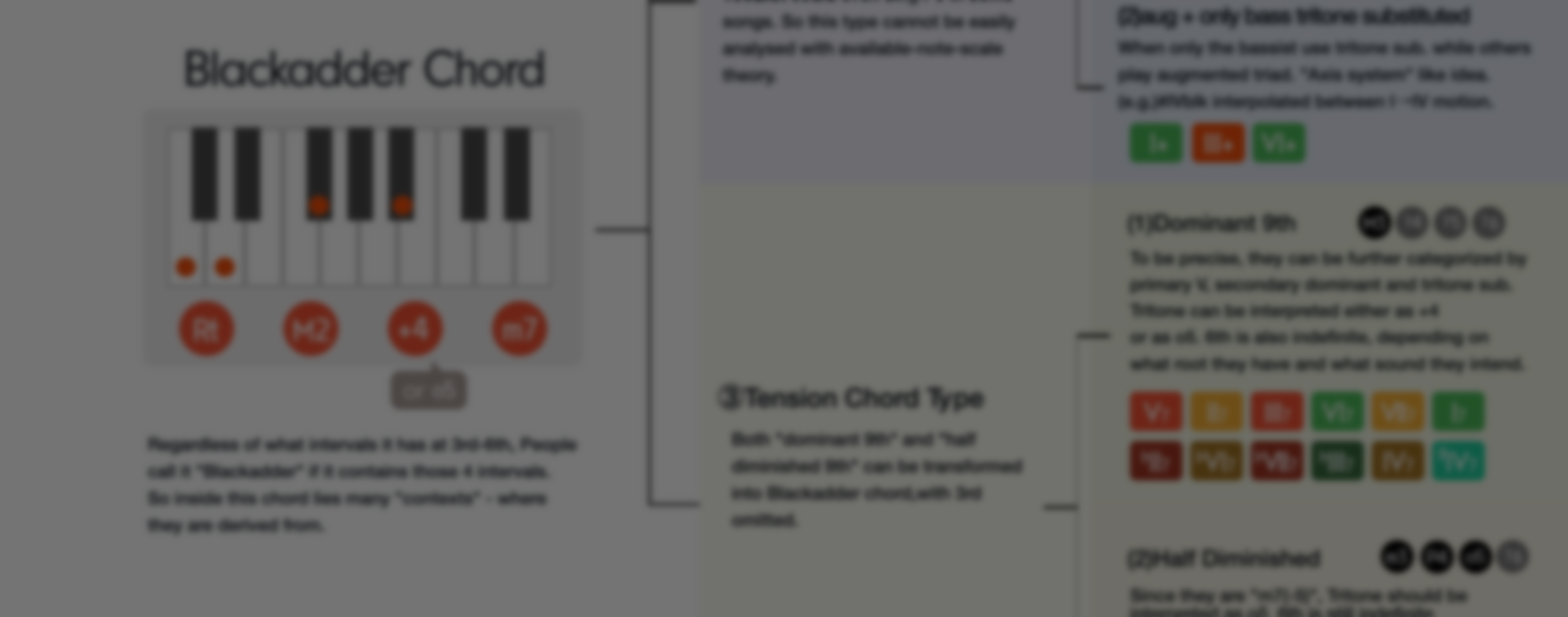Contents
6. Considerations and Applications
So far, we have divided Blk into six types…
Some of you may have had doubts while reading:”Which category do they belong to, when both major 3rd and minor 3rd are possible, or both slash chords and tension chords are reasonable?”
In reality, Blk can belong to multiple types simultaneously. And that’s only natural. While the diagram above represents it in a tree-like structure, what happens in actual music is even more temporal and intricate.
Just having Blk chord tones sounding doesn’t confirm anything; it remains chaotic. It goes through a process where the information obtained from the context narrows down the possible types
So, rather than saying “it can fit into multiple systems,” it’s more accurate to say that “until it settles into one, it is always in a state where multiple possibilities overlap”.
This is not an uncommon phenomenon. For example, when a power chord is played alone, it’s impossible to determine whether the scale it fits into is major or minor. It’s essentially the same story; it’s only when you consider factors like established tonality, root intervals, and interaction with phrases that the meaning of a chord is fully revealed.
World of Polysemy
In the articles following Chapter VIII, “Multiplicity and uncertainty of chord meanings” becomes a central theme. How do we specify the meaning of a chord? What do we anticipate when listening to music? In this article as well, I would like to delve a little into the profound aspects of music.
Multiplicity of Context
Among Blk chords, ♯IVblk, in particular, is versatile and commonly used, which is hypothesized to be due to the variety of contexts that ♯IVblk can simultaneously hold.
First, when seen as an “bass-flipped aug”, the upper I+ is a very well-known pattern for the use of augmented chords. Typically, I precedes it, followed by IV.
Alternatively, when seen as an “accidental chord,” the root ♯IV can serve as a chromatic passing point between V and IV. It doesn’t work that way if the root pitch is diatonic.
Moreover, ♯IVø is well-known as a killer technique in pop music, and ♯IV7, although not commonly used in pop, is found in jazz vocabulary as a kind of substitute dominant. Both of these tend to target IV as the subsequent chord.
Even without considering the special case of the whole-tone system, ♯IVblk encompasses such a wide range of possibilities. In this regard, ♯IV stands out among all roots.
- IVΔ7III7VIm9VIm/V
IVblk
When the context is diversified, it becomes easier to incorporate into chord progressions—As there are many ways for ♯IV to reach Blk, the encounter rate naturally increases, and listeners find it easier to accept. In fact, There even is a possibility that each listener perceives it as the most familiar quality among 7, ø, and aug, and accepts it as a subtype. This is indeed a characteristic that epitomizes the “polyphormism” of blk.
Therefore, when discussing Blk, the absence of the 3rd is extremely important. If it actually sounds like a major third or a minor third, it simply becomes an instance of a dominant seventh or a half-diminished, and all of these profound nuances are lost.
What about other roots…?
The richness of context varies depending on the root. For example, Blk with the root I doesn’t offer as much potential for interpretation.
If we consider it as an “bass-flipped aug,” the upper would be II+, ♯IV+, or ♭VII+, but…… None of which are particularly familiar. Or, the root of I, being diatonic, cannot serve as a chromatic passing chord, hence no chance for accidental chords. And, it’s quite rare to form a half-diminished chord on the tonic. Ultimately, in a practical sense, it boils down to the secondary dominant I7, the dominant ninth type.
- IVΔ7III7VIm9Vm7I7(-5,9,omit3)
This is how it’s typically used. Compared to when it’s ♯IVblk, it’s like a situation of “one-party dominance”, with the likelihood of domi9 being markedly high.
Comparing I7 and IV7, the former is so much more popular. But when it comes to Iblk and
IVblk, the latter is easier to use. Why? When that question arises, the answer should lies in this multiplicity of contexts.
Manipulating Listener Perception
Even with the same chord structure, the way people perceive its meaning can vary. This characteristic seems ripe for practical ideas. So, next, let’s consider applications where careful adjustments in the context and melody lead the listener’s perception in a certain direction. It’s about guiding human brain through subtle musical gestures, essentially, mind control! 😈
This starts from repetitions of C and C+. On measure 8 it goes into Fblk and progress to Bm7!
And taking it as IIm, it starts 2-5-1-4 progression in A major key.
This is a rather interesting example in which Fblk goes to BΔ7 and taking it as IV, it starts 4-5-1-6 progression in F♯ major key. It’s modulation tritone away. Nonetheless, it sounds super smooth!
Blk as a pivot chord. Pivot chord itself is a very common technique, but in both cases Blk plays an intelligent trick : On entrance he disguises himself an Aug chord, while on exit he pretends to be a Dominant Seventh chord.
I carefully controlled the balance of chord tones and other intervals in order to gradually weaken the scent of Aug, transforming it gradually from “Slashed Chord Type” into “Dominant 9th Type”, which end up as solid Domi9 with the appearance of A#, the M3rd interval for F#blk. Only Multiplex-Context chords can perform such chameleon-like strategy.
This is beyond what current music theory deals with. This “context metamorphosis” is of great use for modulation. I reckon you can travel almost anywhere by way of Blk!
Lessons from Blk
The “Chameleon Strategy” was an intriguing technique of altering the maning of a chord, within a single chord itself. This happens to shine a spotlight on aspects that conventional chord theory has discarded for the sake of convenience. Specifically, the following points:
| Conventional Thinking | “Chameleon Strategy” |
|---|---|
| Viewing music at the chord level | Examining the intricacies within the chord |
| Comprehensive analysis incl. following chords | Analyzing each momentary experience |
| Quality is fixed | Quality can be subject to interpretation |
| Uncertainty is supplemented by interpretation | Uncertainty is utilized for its ambiguity |
Those listed under “Conventional Thinking” are all fundamental concepts underlying chord theory. However, the “Chameleon Strategy” approach diverges entirely from this foundation. Therefore, analyzing the previous example with “Conventional Thinking” might lead to interpretations like the following:
While such explanations may seem elegant and simple at first, they come with literal simplifications. Discarding the information that the upper is an augmented may save on data size, but it eliminates ideas like the “Chameleon Strategy.” Moreover, while it’s a fact that listeners do perceive an “aug quality”, covering it up with logic is counterproductive.
Theory does indeed simplify music, but remember, it only serves to make music appear simple, not to actually simplify music itself.
7. Summary
Well, that concludes the lengthy explanation. Let’s summarize the content.
Regarding Terminology and Nomenclature
While there are various other terms for the Blackadder Chord, on this site, out of respect for Joshua Taipale, who diligently transcribed and created videos for 7 examples alone, I’m gonna use this name.
 Joshua Taipale
Joshua TaipaleAs for the usage of the term “Blackadder Chord,” it’s advisable to use it with the following awareness:
- Use it as a “generic term” regardless of type or spelling.
- Use it when the context is not narrowed down to one, and the chord name is unclear.
How to represent a chord in a state where the spelling is not fixed is a somewhat ambiguous area in current chord theory. Having a generic term for polymorphic chords like Blk would be convenient.
In analysis, it’s best not to simply conclude with “Ah, it’s a Blk,” but rather to analyze delicate aspects such as which type possibilities have been eliminated and which remain prominent. Doing so should yield significant insights.
So, when asked what a “Blackadder Chord” is, it’s simply a chord with the formation [0,2,6,10], nothing else.
However, what you can find depends on the theoretical system used to observe it. This is similar to the Neapolitan chord. It’s a “terminal” where many contexts intersect, and the more “routes” you know, the more freely you can “transfer”. It is really an intriguing chord.
Back to TOC

